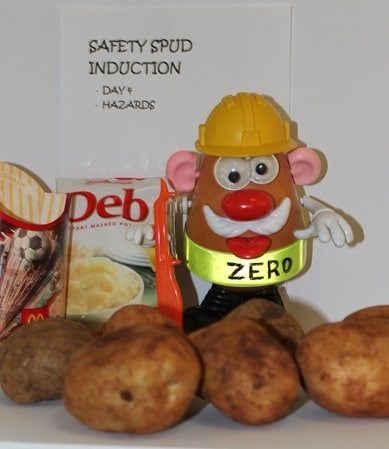Risk and Safety Rituals
Rituals are the foundation of cultural belonging and identity. You can’t really understand or influence culture without a good grasp of rituals and artefacts. The idea that behaviours (‘what we do around here’) define culture is one of the grand delusions of simplistic risk and safety. For those who are unfamiliar with rituals the January 17 Issue of New Scientist (‘Dark Rites’) is a good overview.
The dimensions of ritual is extraordinary, from the way we get up and have breakfast or brush our teeth, to elaborate social festivals and religious celebrations. Most rituals are practiced religiously, although the ritual itself may not be religious. Rituals make for comfort, belonging, security, acceptance and learning, all very powerful social psychological forces that influence daily individual and organizational life. Sometimes the best way to learn about a ritual is to break one.
The excess of rituals can lead to Obsessive Compulsive Disorder (OCD) so that a person with OCD cannot function without the ritual or rituals. I know a number of people who don’t feel safe unless they have conducted a number of rituals before entering a car or plane. This may include touching things a certain way, sitting in a certain position or undertaking some routine with superstitious rigour. I know one such person who has to walk around the car and touch every handle with the back of his hand before he gets in and drives. He rubs the steering wheel in a certain way too and eventually starts the car but his rituals take up to 5 minutes. All of these rituals are connected to his feeling of safety and if he can’t do them, he won’t drive.
Often the development of ritual occurs through attribution (or fundamental attribution error) when success or luck is attributed to some thing or action. This is how the superstitious rituals of sports people start.
Rituals are not ‘stupid’, nor ‘irrational’ but rather non-rational and often have enormous social psychological power through attribution and social belonging. To many not initiated or a member of a group, rituals appear ‘stupid’, irrational and illogical. Regardless of perception, rituals make sense. If one cannot detect and understand ritual, one is not likely to understand and influence culture.
Many acts of faith (religious or non-religious) are powerful and formative, often through symbolic and semiotic value. Often rituals tell a story, create identity and manufacture meaning. So, rituals need to be understood culturally and historically not rationally. It doesn’t matter whether one joins a bikie gang, in-group at work or a church, rituals make sense. Rituals are a way of organizing to help manage belonging, identity and dissonance.
Rituals are also methods of demarcation, a way of making in-group and out-groupness. It doesn’t matter whether it is a tattoo or a small piece of skin cut off the end of a penis, wars have been fought for less. The growth of brands and territory between religious groups and denominations, are often signified by rituals with water, food, body actions and dress. How much water you use in baptism and the mode of using it can make all the difference. The amount of hair at the side of the head or how hair is shaped can make one either ‘in’ or ‘out’.
When I was a kid teenage groups of ‘bodgies’ and ‘widges’ were a symbol of adolescent rebellion. Hair and dress became sub-cultural artefacts and a ‘language’ to all. Artefacts are grammar in cultural formation. I remember my eldest brother putting on layers of ‘Brylcreem’ and getting the front tube-curl just right before he could go out on a Saturday night. The style (completed with a brush-type bug rake) was sides brushed back and front pushed forward. Elvis and James Dean were symbols of the style. Later, with the Beatles it was long hair over the ears and with Led Zeppelin, Deep Purple and Cream, down to the shoulders.
So, what has all this got to do with risk and safety? Let’s just explore five things about ritual as a starter.
1. It’s time rituals and artefacts, language and semiotics were brought back into an understanding of culture. The behaviourist nonsense and BBS delusion of culture as ‘what we do around here’ simply mis-educates everyone.
2. Rituals have meaning and can lose meaning. People can be desensitized to thinking through rituals so that tasks are performed that have lost meaning and sense. I wonder what meaningless risk and safety rituals are in your workplace? Are there things being done that are nothing more than ‘going through the motions’? Do some rituals need to be re-invigorated?
3. Rituals can have religious and ideological power with dangerous effect. For example, adopting the language of zero ritualistically without thinking how its language and discourse drives absolutism and perfectionism. What happens in your workplace when you question the sacredness of zero? Has your workplace renamed the safety person with the sacred zero name and removed the word safety from cultural language?
4. Establishing rituals in risk and safety can establish superior and subordinate roles. This makes it clear who gives the orders and who takes them, who are in authority and who are ‘idiots’. So, without raising questions demands are put on the subordinates allowing some to repress others in the name of safety. There are no qualms or protests on assaulting others freedoms and dignity if we invoke the sacred name of safety. Are you aware how safety is being used this way? Do those in authority hide behind safety when indeed, when what is enacted has nothing to do with safety at all?
5. Have you become OCD in risk and safety? What rituals have more to do with the feeling of safety than safety? Are there some rituals that should just quietly slip away to nowhere? Are there safety rituals at work that have much more to do with superstition and belonging than safety?
Perhaps next safety walk it might be good to broaden observations beyond the physical to a more spacial, cultural and visual walk. Perhaps there is much more to learn about culture and influencing culture than the BBS carrot and stick. Perhaps a study of rituals might help improve safety without doing much at all. Perhaps you could develop some new rituals that could influence organizational culture to be more mindful of safety? Maybe, your safety walk itself has become a meaningless rituals that needs some reinvigoration with meaning and purpose?




Do you have any thoughts? Please share them below